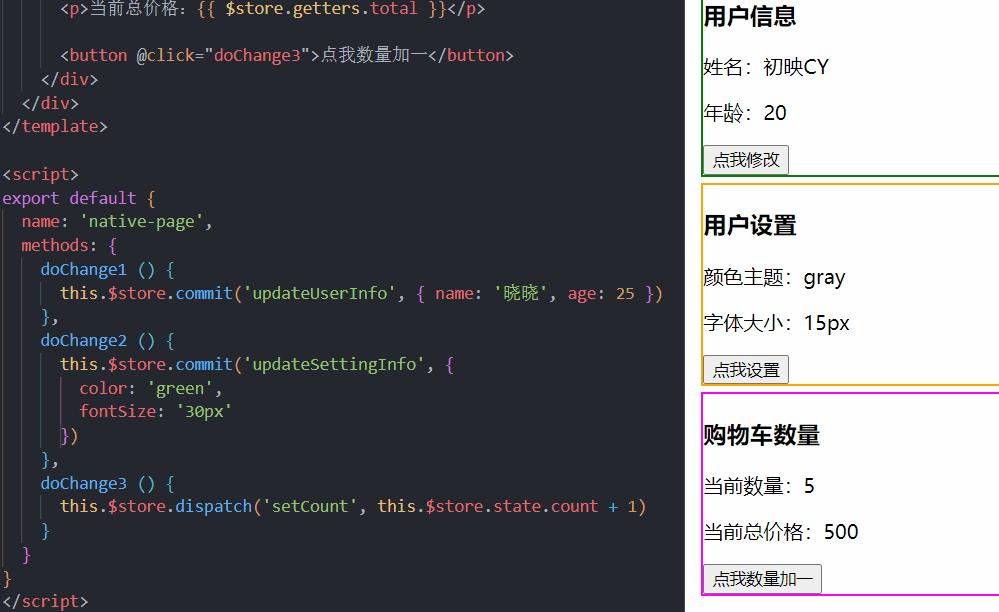🥳博 主:初映CY的前说(前端领域)
🌞个人信条:想要变成得到,中间还有做到!
🤘本文核心:vuex基础认识、state、getters、mutations actions、modules使用
目录(文末有原素材喔)
一、vuex介绍
1.vuex概念引入:
2.为什么要有vuex
3.Vuex使用场景
4.vuex工作流程:
二、五大核心配置项
1.state
①原生写法
②state辅助函数mapSaatate
2.getters
①原生写法
②getters辅助函数mapGetters
3.mutations
①原生写法
②mutations辅助函数mapMutations
4.actions
①原生写法
②actions辅助函数mapActions
5.modules
①原生写法
②modules封装写法
【vuex辅助函数源素材】
一、vuex介绍
1.vuex概念引入:
当我们修改其中一个头像的时候,我们怎么同步到多个组件当中呢?

用vuex来对非父子关系传值
2.为什么要有vuex
- vuex的作用是解决多组件状态共享的问题,在大型的项目中,组件通讯会变得很混乱,使用vuex可以统一管理组件之间的通讯
- vuex是响应式布局: 只要vuex中的数据变化,对应的组件会自动更新(类似于vue数据驱动)
3.Vuex使用场景
不是所有的场景都适用于vuex,只有在必要的时候才使用vuex,如果不必要,尽量别用
1..适合使用vuex场景
- 这个数据需要在很多个地方要写,如果采用组件传值方式,写起来很麻烦,而且多个地方都要写
- 例如:用户信息(姓名,头像),可能会在很多个地方使用(个人页面,评论页面等)
2.不适合使用vuex场景
- 这个数据
不需要多个地方使用,如果某个数据仅仅只是在两个组件之间通讯,优先使用props或$emit
3.vuex特点
- 所有组件数据共享
- 响应式: 一旦vuex数据修改,所有使用的地方都会自动更
4.vuex工作流程:
我们先触发了Actions中的异步操作,当异步结果出来之后(如果没有异步操作则直接执行后面的操作),我们触发commit调用mutations去修改我们的state,最后因为我们是具有响应式的特点,因此我们的数据被修改成功。
二、五大核心配置项
1.state
①原生写法
1.概念:
state提供vuex唯一的公共数据源,所有共享的数据都要统一放到store中的State中存储。
2.声明语法:
state:{
//在此处写共享属性即可
}3.使用语法:
$store.state.属性名
举个例子:
1.声明:

2.使用:

可以看出我们的存放在state中的数据被我们成功的获取到啦!
②state辅助函数mapSaatate
1.概念:
将vuex中的数据映射到组件的计算属性中,简化书写操作(写在computed中)
2.使用方法:
1.导入import { mapState } from 'vuex'
2. ...mapState([‘state中属性名’])
3.举个例子

2.getters
①原生写法
1.概念:
state的计算属性
2.声明语法:
getters: {
计算属性名()(state) {
return 要返回的值
}
}3.使用语法
$store.getters.getter名
举个例子
1.声明

2.使用

可以看出我们的存放在getters中的数据被我们成功的获取到了,注意步骤是getters下
②getters辅助函数mapGetters
1.概念:
同上是简化我们的写法(写在computed中)
2.使用方法:
1.导入import { mapGetters } from 'vuex'
2. ...mapGetters([‘getters中计算属性’])
3.举个例子

3.mutations
①原生写法
1.概念:
state数据的修改只能通过mutations,并且mutations必须是同步的。Mutations是同步更新state数据的唯一方式!!!
2.声明语法:
mutations:{
mutation名(state , 载荷 ) {
},每一项都是一个函数,可以声明两个形参:
第一个参数是必须的,表示当前的state。
第二个参数是可选的,表示载荷,是可选的。在使用时要传入的数据
专业术语载荷:表示额外的参数
3.使用语法
this.$store.commit('mutation名', 载荷 )
4.举个例子
1.声明

2.使用

当我们点击按钮的时候,我们荷载(payload)中的数据传到了mutation中随后完成我们的值传递,将我们原始的数据改变。
②mutations辅助函数mapMutations
1.概念:
简化书写操作成方法形式(写在methods中)
2.使用方法:
1.导入import { mapMutations } from 'vuex'
2. ...mapMutations([‘mutations名’])
3.举个例子

4.actions
①原生写法
1.概念:
actions: 异步更新我们的数据(例如你的数据来源于ajax)

2.声明语法:
这个地方的载荷一般为ajax接口需要的参数,如果没有就不用传
actions: {
// context对象会自动传入,它与store实例具有相同的方法和属性
action的名字: function(context, 载荷) {
// 1. 异步操作获取数据
// 2. commit调用mutation来修改数据
// context.commit('mutation名', 载荷)
}
}每一项都是一个函数,可以声明两个形参:
第一个参数是必须的,表示当前的state。
第二个参数是可选的,表示载荷,是可选的。在使用时要传入的数据
专业术语载荷:表示额外的参数
3.使用语法
this.$store.dispath ( 'actions的名字',参数 )
4.举个例子
4.1.声明

4.2.使用

②actions辅助函数mapActions
1.概念:
简化书写操作成方法形式(写在methods中)
2.使用方法:
1.导入import { mapActions } from 'vuex'
2. ...mapmapActions([‘action名’])
3.举个例子

5.modules
①原生写法
1.概念:
模块化处理vuex数据,将我们每个模块的vuex数据分开处理
2.声明语法:
//在我们的store/index.js中书写
modules: {
模块名1: {
// namespaced为true,则在使用mutations时,就必须要加上模块名
namespaced: true,3.使用语法:
//state
全局的: $store.state.数据项名
模块的: $store.state.模块名.数据项名
//getters
全局的: $store.getters.getter名
模块的: $store.getters['模块名/getters名']
//mutations
全局的: $store.commit('mutations名',载荷)
模块的: $store.commit('模块名/mutations名',载荷)
//actions
全局的: $store.dispatch('actions名',载荷)
模块的: $store.dispatch('模块名/actions名',载荷)4.举个例子
4.1声明:
我们先封装模块

在index.js中导入

4.2使用:

需要开启命名空间namespaced:true
②modules封装写法

注意点:我们分了模块,我们的数据要单独的导入进来喔
【vuex辅助函数源素材】
1.先搭建我们的脚手架(务必勾选上以下选项)

2.引入我们的组件
App.vue
<template>
<div>
<!-- 顶部导航栏 -->
<div class="footer_wrap">
<!-- 路由导航 -->
<!-- <router-link to="/native">原生写法</router-link> -->
<router-link to="/facilitate">辅助函数写法</router-link>
</div>
<!-- 下面内容 -->
<div class="top">
<!-- 路由出口 -->
<router-view></router-view>
</div>
</div>
</template>
<script>
export default {
name: 'facilitate-page',
methods: {}
}
</script>
<style scoped>
body,
html {
margin: 0;
padding: 0;
}
.footer_wrap {
position: fixed;
left: 0;
top: 0;
display: flex;
width: 100%;
text-align: center;
background-color: #333;
color: #ccc;
}
.footer_wrap a,
span {
cursor: pointer;
flex: 1;
text-decoration: none;
padding: 15px 0;
line-height: 20px;
background-color: #333;
color: #ccc;
border: 1px solid black;
}
.footer_wrap a:hover,
span:hover {
background-color: #555;
}
.top {
padding-top: 50px;
}
.footer_wrap .router-link-active {
background-color: #000;
}
</style>Facilitate.vue(Views/ Facilitate.vue)
<template>
<div>
<h2>辅助函数写法</h2>
<div class="user">
<h3>用户信息</h3>
<p>姓名:{{ userInfo.name }}</p>
<p>年龄:{{ userInfo.age }}</p>
<button @click="doChange1">点我修改</button>
</div>
<div class="setting">
<h3>用户设置</h3>
<p>颜色主题:{{ settingInfo.color }}</p>
<p>字体大小:{{ settingInfo.fontSize }}</p>
<button @click="doChange2">点我设置</button>
</div>
<div class="shopcar">
<h3>购物车数量</h3>
<p>当前数量:{{ count }}</p>
<p>当前总价格:{{ total }}</p>
<button @click="doChange3">点我数量加一</button>
</div>
</div>
</template>
<script>
// 导入辅助函数
import { mapState, mapGetters, mapMutations, mapActions } from 'vuex'
export default {
name: 'facilitate-page',
computed: {
...mapState('user', ['userInfo']),
...mapState('setting', ['settingInfo']),
...mapState('shopcar', ['count']),
...mapGetters('shopcar', ['total'])
},
methods: {
...mapMutations('user', ['updateUserInfo']),
...mapMutations('setting', ['updateSettingInfo']),
...mapActions('shopcar', ['setCount']),
// 1.点击修改信息
doChange1 () {
// 提交mutations
this.updateUserInfo({
name: '结束啦',
age: 666
})
},
// 2.点击修改设置
doChange2 () {
// 提交mutations
this.updateSettingInfo({ color: 'green', fontSize: '20px' })
},
// 3.点击购买按钮
doChange3 () {
// 提交actions
this.setCount(this.count + 1)
}
}
}
</script>
<style scoped>
.user {
border: 2px solid green;
margin: 5px;
}
.setting {
border: 2px solid orange;
margin: 5px;
}
.shopcar {
border: 2px solid magenta;
margin: 5px;
}
</style>3.引入路由
index.js (router/index.js)
import Vue from 'vue'
import VueRouter from 'vue-router'
// 1.导入组件
// import native from '@/views/Native.vue'
import facilitate from '@/views/Facilitate.vue'
Vue.use(VueRouter)
// 2.路由规则
const routes = [
// { path: '/', redirect: '/Native' },
// { path: '/native', component: native },
{ path: '/facilitate', component: facilitate }
]
const router = new VueRouter({
routes
})
export default router愿这一份资料能帮帮助到你,如果可以请关注博主呦!!!



















